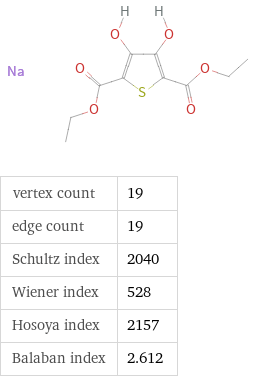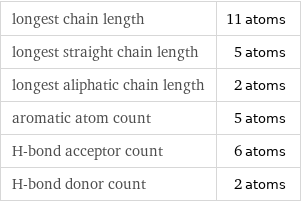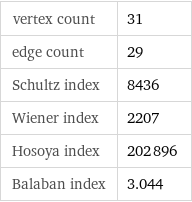Input interpretation

3, 4-dihydroxythiophene-2, 5-dicarboxylic acid diethyl ester disodium salt
Basic properties
![molar mass | 306.2 g/mol formula | C_10H_12Na_2O_6S empirical formula | Na_2C_10O_6S_H_12 SMILES identifier | CCOC(=O)C1=C(C(=C(C(=O)OCC)S1)O)O.[Na].[Na] InChI identifier | InChI=1/C10H12O6S.2Na/c1-3-15-9(13)7-5(11)6(12)8(17-7)10(14)16-4-2;;/h11-12H, 3-4H2, 1-2H3;; InChI key | RIUHHQINFXZTAF-UHFFFAOYSA-N](../image_source/b71ac3f73c3c0365325fb2b62e8a0cc4.png)
molar mass | 306.2 g/mol formula | C_10H_12Na_2O_6S empirical formula | Na_2C_10O_6S_H_12 SMILES identifier | CCOC(=O)C1=C(C(=C(C(=O)OCC)S1)O)O.[Na].[Na] InChI identifier | InChI=1/C10H12O6S.2Na/c1-3-15-9(13)7-5(11)6(12)8(17-7)10(14)16-4-2;;/h11-12H, 3-4H2, 1-2H3;; InChI key | RIUHHQINFXZTAF-UHFFFAOYSA-N
Structure diagram

vertex count | 19 edge count | 19 Schultz index | 2040 Wiener index | 528 Hosoya index | 2157 Balaban index | 2.612
Quantitative molecular descriptors

longest chain length | 11 atoms longest straight chain length | 5 atoms longest aliphatic chain length | 2 atoms aromatic atom count | 5 atoms H-bond acceptor count | 6 atoms H-bond donor count | 2 atoms
Elemental composition

Find the elemental composition for 3, 4-dihydroxythiophene-2, 5-dicarboxylic acid diethyl ester disodium salt in terms of the atom and mass percents: atom percent = N_i/N_atoms × 100% mass percent = (N_im_i)/m × 100% Plan: • Write the chemical formula and gather atomic masses from the periodic table. • Determine values for N_i, m_i, N_atoms and m using these items. • Finally, compute the percents and check the results. Write the chemical formula: C_10H_12Na_2O_6S Use the chemical formula, C_10H_12Na_2O_6S, to count the number of atoms, N_i, for each element and find the total number of atoms, N_atoms: | number of atoms Na (sodium) | 2 C (carbon) | 10 O (oxygen) | 6 S (sulfur) | 1 H (hydrogen) | 12 N_atoms = 2 + 10 + 6 + 1 + 12 = 31 Divide each N_i by N_atoms to calculate atom fractions. Then use the property that atom fractions must sum to one to check the work: | number of atoms | atom fraction Na (sodium) | 2 | 2/31 C (carbon) | 10 | 10/31 O (oxygen) | 6 | 6/31 S (sulfur) | 1 | 1/31 H (hydrogen) | 12 | 12/31 Check: 2/31 + 10/31 + 6/31 + 1/31 + 12/31 = 1 Compute atom percents using the atom fractions: | number of atoms | atom percent Na (sodium) | 2 | 2/31 × 100% = 6.45% C (carbon) | 10 | 10/31 × 100% = 32.3% O (oxygen) | 6 | 6/31 × 100% = 19.4% S (sulfur) | 1 | 1/31 × 100% = 3.23% H (hydrogen) | 12 | 12/31 × 100% = 38.7% Look up the atomic mass, m_i, in unified atomic mass units, u, for each element in the periodic table: | number of atoms | atom percent | atomic mass/u Na (sodium) | 2 | 6.45% | 22.98976928 C (carbon) | 10 | 32.3% | 12.011 O (oxygen) | 6 | 19.4% | 15.999 S (sulfur) | 1 | 3.23% | 32.06 H (hydrogen) | 12 | 38.7% | 1.008 Multiply N_i by m_i to compute the mass for each element. Then sum those values to compute the molecular mass, m: | number of atoms | atom percent | atomic mass/u | mass/u Na (sodium) | 2 | 6.45% | 22.98976928 | 2 × 22.98976928 = 45.97953856 C (carbon) | 10 | 32.3% | 12.011 | 10 × 12.011 = 120.110 O (oxygen) | 6 | 19.4% | 15.999 | 6 × 15.999 = 95.994 S (sulfur) | 1 | 3.23% | 32.06 | 1 × 32.06 = 32.06 H (hydrogen) | 12 | 38.7% | 1.008 | 12 × 1.008 = 12.096 m = 45.97953856 u + 120.110 u + 95.994 u + 32.06 u + 12.096 u = 306.23953856 u Divide the mass for each element by m to calculate mass fractions. Then use the property that mass fractions must sum to one to check the work: | number of atoms | atom percent | mass fraction Na (sodium) | 2 | 6.45% | 45.97953856/306.23953856 C (carbon) | 10 | 32.3% | 120.110/306.23953856 O (oxygen) | 6 | 19.4% | 95.994/306.23953856 S (sulfur) | 1 | 3.23% | 32.06/306.23953856 H (hydrogen) | 12 | 38.7% | 12.096/306.23953856 Check: 45.97953856/306.23953856 + 120.110/306.23953856 + 95.994/306.23953856 + 32.06/306.23953856 + 12.096/306.23953856 = 1 Compute mass percents using the mass fractions: Answer: | | | number of atoms | atom percent | mass percent Na (sodium) | 2 | 6.45% | 45.97953856/306.23953856 × 100% = 15.01% C (carbon) | 10 | 32.3% | 120.110/306.23953856 × 100% = 39.22% O (oxygen) | 6 | 19.4% | 95.994/306.23953856 × 100% = 31.35% S (sulfur) | 1 | 3.23% | 32.06/306.23953856 × 100% = 10.47% H (hydrogen) | 12 | 38.7% | 12.096/306.23953856 × 100% = 3.950%
Elemental oxidation states

The first step in finding the oxidation states (or oxidation numbers) in 3, 4-dihydroxythiophene-2, 5-dicarboxylic acid diethyl ester disodium salt is to draw the structure diagram. Next set every oxidation number equal to the atom's formal charge: In 3, 4-dihydroxythiophene-2, 5-dicarboxylic acid diethyl ester disodium salt hydrogen is not bonded to a metal with lower electronegativity, so it will have an oxidation state of +1. Any element bonded to hydrogen gains the bonding electrons, decreasing their oxidation state by 1 for every bond: With hydrogen out of the way, look at the remaining bonds. There are 8 carbon-oxygen bonds, 2 carbon-sulfur bonds, and 7 carbon-carbon bonds. For each of these bonds, assign the bonding electrons to the most electronegative element. First examine the carbon-oxygen bonds: element | electronegativity (Pauling scale) | C | 2.55 | O | 3.44 | | | Since oxygen is more electronegative than carbon, the electrons in these bonds will go to oxygen. Decrease the oxidation number for oxygen in every highlighted bond (by 1 for single bonds, 2 for double bonds, and 3 for triple bonds), and increase the oxidation number for carbon accordingly: Next look at the carbon-sulfur bonds: element | electronegativity (Pauling scale) | C | 2.55 | S | 2.58 | | | Since sulfur is more electronegative than carbon, the electrons in these bonds will go to sulfur: Next look at the carbon-carbon bonds: element | electronegativity (Pauling scale) | C | 2.55 | C | 2.55 | | | Since these elements are the same the bonding electrons are shared equally, and there is no change to the oxidation states: Now summarize the results: Answer: | | oxidation state | element | count -3 | C (carbon) | 2 -2 | O (oxygen) | 6 | S (sulfur) | 1 -1 | C (carbon) | 2 0 | Na (sodium) | 2 +1 | C (carbon) | 4 | H (hydrogen) | 12 +3 | C (carbon) | 2
Topological indices

vertex count | 31 edge count | 29 Schultz index | 8436 Wiener index | 2207 Hosoya index | 202896 Balaban index | 3.044